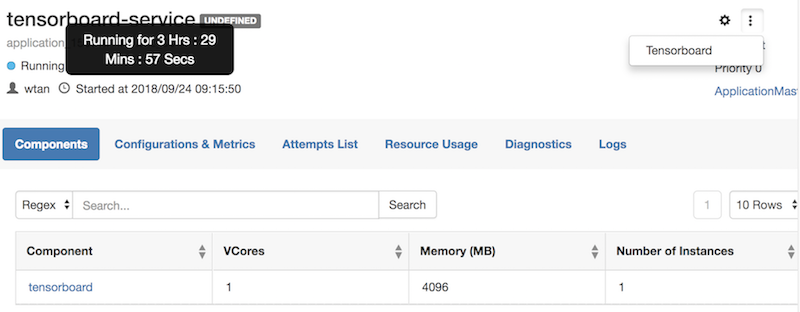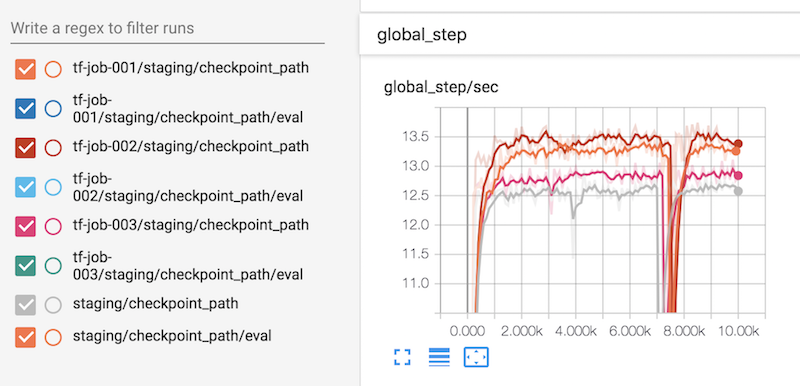

Must:
Optional:
usage: job run
-checkpoint_path <arg> Training output directory of the job, could
be local or other FS directory. This
typically includes checkpoint files and
exported model
-docker_image <arg> Docker image name/tag
-env <arg> Common environment variable of worker/ps
-input_path <arg> Input of the job, could be local or other FS
directory
-name <arg> Name of the job
-num_ps <arg> Number of PS tasks of the job, by default
it's 0
-num_workers <arg> Numnber of worker tasks of the job, by
default it's 1
-ps_docker_image <arg> Specify docker image for PS, when this is
not specified, PS uses --docker_image as
default.
-ps_launch_cmd <arg> Commandline of worker, arguments will be
directly used to launch the PS
-ps_resources <arg> Resource of each PS, for example
memory-mb=2048,vcores=2,yarn.io/gpu=2
-queue <arg> Name of queue to run the job, by default it
uses default queue
-saved_model_path <arg> Model exported path (savedmodel) of the job,
which is needed when exported model is not
placed under ${checkpoint_path}could be
local or other FS directory. This will be
used to serve.
-tensorboard <arg> Should we run TensorBoard for this job? By
default it's true
-verbose Print verbose log for troubleshooting
-wait_job_finish Specified when user want to wait the job
finish
-worker_docker_image <arg> Specify docker image for WORKER, when this
is not specified, WORKER uses --docker_image
as default.
-worker_launch_cmd <arg> Commandline of worker, arguments will be
directly used to launch the worker
-worker_resources <arg> Resource of each worker, for example
memory-mb=2048,vcores=2,yarn.io/gpu=2
yarn jar path-to/hadoop-yarn-applications-submarine-3.2.0-SNAPSHOT.jar job run \ --env DOCKER_JAVA_HOME=/usr/lib/jvm/java-8-openjdk-amd64/jre/ \ --env DOCKER_HADOOP_HDFS_HOME=/hadoop-3.1.0 --name tf-job-001 \ --docker_image <your-docker-image> \ --input_path hdfs://default/dataset/cifar-10-data \ --checkpoint_path hdfs://default/tmp/cifar-10-jobdir \ --worker_resources memory=4G,vcores=2,gpu=2 \ --worker_launch_cmd "python ... (Your training application cmd)" \ --tensorboard # this will launch a companion tensorboard container for monitoring
1) DOCKER_JAVA_HOME points to JAVA_HOME inside Docker image.
2) DOCKER_HADOOP_HDFS_HOME points to HADOOP_HDFS_HOME inside Docker image.
3) --worker_resources can include gpu when you need GPU to train your task.
4) When --tensorboard is specified, you can go to YARN new UI, go to services -> <you specified service> -> Click ... to access Tensorboard.
This will launch a Tensorboard to monitor all your jobs. By access YARN UI (the new UI). You can go to services page, go to the tensorboard-service, click quick links (Tensorboard) can lead you to the tensorboard.
See below screenshot:

yarn jar hadoop-yarn-applications-submarine-<version>.jar job run \ --name tf-job-001 --docker_image <your docker image> \ --input_path hdfs://default/dataset/cifar-10-data \ --checkpoint_path hdfs://default/tmp/cifar-10-jobdir \ --env DOCKER_JAVA_HOME=/usr/lib/jvm/java-8-openjdk-amd64/jre/ \ --env DOCKER_HADOOP_HDFS_HOME=/hadoop-3.1.0 \ --num_workers 2 \ --worker_resources memory=8G,vcores=2,gpu=1 --worker_launch_cmd "cmd for worker ..." \ --num_ps 2 \ --ps_resources memory=4G,vcores=2,gpu=0 --ps_launch_cmd "cmd for ps" \
yarn jar hadoop-yarn-applications-submarine-3.2.0-SNAPSHOT.jar job show --name tf-job-001
Output looks like:
Job Meta Info: Application Id: application_1532131617202_0005 Input Path: hdfs://default/dataset/cifar-10-data Checkpoint Path: hdfs://default/tmp/cifar-10-jobdir Run Parameters: --name tf-job-001 --docker_image wtan/tf-1.8.0-gpu:0.0.3 (... all your commandline before run the job)
After that, you can run tensorboard --logdir=<checkpoint-path> to view Tensorboard of the job.
# Cleanup previous service if needed yarn app -destroy tensorboard-service; \ yarn jar /tmp/hadoop-yarn-applications-submarine-3.2.0-SNAPSHOT.jar \ job run --name tensorboard-service --verbose --docker_image wtan/tf-1.8.0-cpu:0.0.3 \ --env DOCKER_JAVA_HOME=/usr/lib/jvm/java-8-openjdk-amd64/jre/ \ --env DOCKER_HADOOP_HDFS_HOME=/hadoop-3.1.0 \ --num_workers 0 --tensorboard
You can view multiple job training history like from the Tensorboard link:
